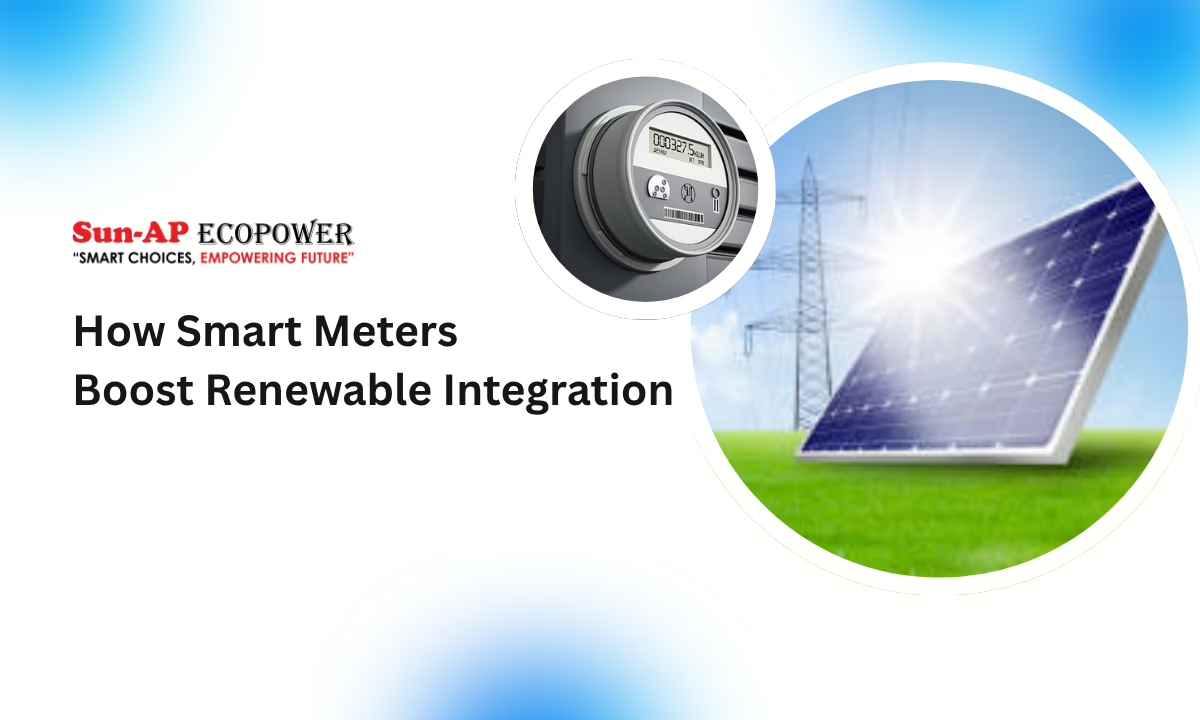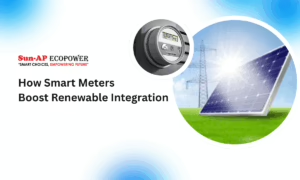As someone working at Sun-Ap Ecopower, I’ve seen firsthand how smart meters are becoming a cornerstone in our shift toward clean energy. From rooftop solar installations to utility-scale wind farms feeding the grid, the role of a smart meter isn’t just that of a passive meter-reading device. It’s a communication hub, a data collector, and the gatekeeper between energy generation and consumption.
In this blog, I’ll show how smart meters and their ecosystem help integrate renewable energy sources, support net metering, enhance grid resilience, and enable homes and businesses to actively engage in the energy transition.
Smart Energy Meters

When I say “smart energy meters,” I mean devices that go beyond kWh totals. Smart energy meters combine metrology, communications, and sometimes local intelligence (edge computing) to record consumption/generation in short intervals, transmit that data securely, and accept remote configuration or firmware updates. Their ability to support two-way flows is what differentiates them from legacy meters and makes them a core component of the modern grid.
Smart Electricity Meter Features
A modern smart electricity meter typically includes these features (and these are the features we look for when advising clients):
- High-resolution interval recording (15 minutes or better).
- Bi-directional metering for export/import accounting.
- Communications module (RF mesh, cellular, PLC, or NB-IoT).
- Tamper and anomaly detection sensors.
- Compatibility with Meter Data Management Systems (MDMS).
- Support for time-of-use or dynamic tariff signaling.
- Capability for prepaid or postpaid operation, depending on utility needs.
These features allow the meter to be much more than a billing device; they turn it into a value-creation point for both consumers and utilities.
Smart Meters Benefits
Smart meters deliver a set of tangible benefits that accelerate renewable integration and improve overall system efficiency:
- Accurate measurement of export/import: For prosumers with rooftop solar, smart meters record exactly how much energy is generated, consumed, and exported, enabling fair net metering settlement.
- Real-time visibility: Utilities and consumers get near-real-time data that improves forecasting and operational decisions.
- Time-of-use enabling: Smart meters make dynamic tariffs and demand response possible, aligning consumption with renewable generation patterns.
- Loss reduction and tamper detection: By detecting anomalies and unauthorized draws, smart meters help reduce technical and commercial losses. Improving utility finances and reducing tariff pressure.
- Integration enabler: They act as the data interface that allows distributed renewable assets to participate in grid services.
These benefits are what make smart meters indispensable when we talk about large-scale renewable uptake.
Smart Meters For Home
For homeowners, a smart meter unlocks actionable insights. When I visit customers installing rooftop solar, I show them how the meter’s dashboard reveals generation curves, export spikes, and periods of high import. That visibility helps families shift high-load activities like washing, EV charging, or water heating to times when solar is abundant or tariffs are low. For homes with batteries, the smart meter helps coordinate charge/discharge cycles for maximum self-consumption and lower bills. In short, smart meters turn a house into a smart energy node.
Smart Meters Cost
Cost is often a first concern. Smart meters vary in price depending on capabilities (bi-directional metering, communication stack, certification). Under many national programs in India, deployment is subsidized or part of a utility capex rollout, meaning homeowners and small businesses may not bear the full hardware cost. When costs are passed to consumers, we recommend evaluating long-term benefits, reduced estimated bills, TOU savings, and higher ROI when paired with solar, rather than only the upfront price.
Smart Meter Recharge
Prepaid smart meters (smart meter recharge) are an increasingly common option in some regions. They let consumers load credit in advance and manage consumption within budget limits. For solar + battery users, prepaid options can be combined with export accounting to ensure transparent crediting when customers feed energy back to the grid. Prepaid modes are useful for budget control and can reduce bill disputes.
Net Metering
Net metering relies on accurate measurement of two-way energy flow. Smart meters make net metering robust by tracking energy exported to the grid when your solar panels produce more than you use, and energy imported when you draw from the grid. This transparent accounting supports fair crediting and reduces reconciliation headaches for utilities and prosumers alike.
Solar Net Metering
Solar net metering is the application of net metering specifically for photovoltaic systems. When we install rooftop PV for clients, the smart meter becomes the definitive record of the system’s performance: how much the panels generate, how much household consumption offsets that generation, and the net export. This data helps in optimizing system sizing, verifying performance guarantees, and maximizing economic returns from the solar investment.
Net Energy Metering
Net energy metering (NEM) is a billing arrangement where exported energy offsets imported energy on a one-to-one or tariff-adjusted basis. Smart meters are essential for implementing NEM at scale because they handle the detailed interval data needed for fair settlement and can support evolving NEM models that use time-of-export valuations rather than simple net totals.
Feston Inverters
When pairing PV systems with inverters like Feston Inverters, the smart meter and inverter together form a control loop. The inverter manages DC-to-AC conversion and can report generation telemetry, while the smart meter validates energy flows at the point of coupling with the grid. This coordination enables accurate export accounting and supports grid compliance and anti-islanding protections. In projects we manage, choosing compatible inverter and meter models avoids integration headaches and improves system reliability.
Secure Meters
Secure Meters are a class of devices designed for high-integrity, certified metering with robust anti-tamper capabilities, something we prioritize when working on commercial and industrial installations. Ensure accurate billing and reliable data for grid operation. For sites where revenue protection or high-value export accounting matters, Secure Meters are the recommended option.
Secure Meters Distributors In India
When procuring secure meters, working with reputable distributors is critical. Distributors in India supply metering hardware with necessary certifications and support for calibration and maintenance. We partner only with distributors who provide traceability, spares, and local support, ensuring the long-term reliability of installations.
Panasonic Solar Panels
High-quality modules such as Panasonic solar panels are often used in our rooftop and commercial projects. Paired with accurate smart metering, these modules deliver transparent performance records and make it straightforward to validate generation claims, warranty performance, and ROI calculations for our clients.
Solar Panel Dealers In India
Solar panel dealers play a central role in ensuring that panels, inverters, and meters are compatible and compliant. At Sun-Ap Ecopower, we collaborate closely with trusted solar panel dealers in India to design systems where the smart meter’s capabilities are matched to the customer’s billing and export requirements, ensuring smooth net metering approvals and reliable performance.
Implementation Considerations And Challenges
- Deploying smart meters for renewable integration involves several practical considerations:
- Communication infrastructure: A reliable telecom backbone (cellular, RF mesh, or PLC) is needed for timely data flows.
- MDMS & analytics: Utilities require Meter Data Management Systems to ingest, cleanse, and analyze the torrent of data.
- Regulatory clarity: Net metering rules, export tariffs, and TOU structures must be well defined.
- Cybersecurity: Protecting meter-to-MDMS channels is critical to prevent data tampering and preserve consumer trust.
Addressing these issues upfront ensures smart meter rollouts deliver their promised value to both prosumers and grid operators.
Wrapping Up
Smart meters are a pivotal link between renewable generation and the grid. They provide the granular data required to settle net metering fairly, enable dynamic pricing and demand response, and give homeowners and businesses the tools to maximize self-consumption and battery utilization. When paired with quality hardware from trusted distributors and supported by robust MDMS platforms and informed consumers, smart meters unlock tangible financial and operational benefits.
At Sun-Ap Ecopower, we guide customers through meter selection, integration, and optimization so that their solar investments deliver maximum value. Smart meters don’t just record electricity: they enable an intelligent energy ecosystem where generation, storage, and consumption work in harmony. Embracing them is not merely a technical upgrade; it’s a strategic step toward a cleaner, more resilient energy future.
FAQs
Q1: Can Smart Meters Be Used With Solar Panels?
Yes, smart meters are essential for measuring both energy generated by your solar panels and energy drawn from the grid, enabling accurate net metering and transparent billing.
Q2: What Is The Role Of A Smart Grid In Renewable Energy?
A smart grid uses monitoring, communication, and automation, including smart meters, to integrate renewable generation, manage variability, and maintain stability across distributed assets.
Q3: What Role Do Smart Meters Play In The Transition To Renewable Energy Sources?
Smart meters give visibility into generation and consumption, enable prosumer participation through net metering, and provide the data needed for demand response and grid balancing.
Q4: How Is The Integration Of Renewable Energy Sources Influencing Power Grids?
Integration is shifting grids from a one-way supply model to a two-way network with many small generators, requiring better data, control, and coordination, functions smart meters help deliver.




